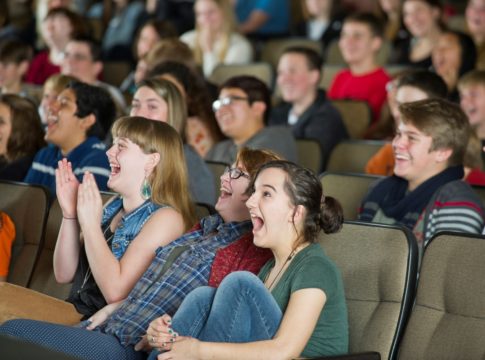Three weeks ago, Montgomery County Public Schools Superintendent Joshua P. Starr unveiled a detailed strategic plan for overhauling the county’s struggling alternative school program. The plan is chock-full of intriguing personalized, competency-based, and online components.
The district began the redesign process of its alternative school programs in 2012 after observing that the current model was providing little improvement in student achievement. As Starr pointed out in his memo to school board members, the alternative school programs’ graduation rate in SY2012–13 was just 8.9 percent compared to the 88.3 percent graduation rate for the county as a whole. Perhaps more telling were the results of a Gallup poll of students in the county’s alternative school programs. According to the poll, 59 percent of students said they felt “stuck” or “discouraged” when asked questions pertaining to hopefulness in school.
Montgomery County Public Schools is hardly the only school district with flagging alternative school programs. Alternative school programs often serve as a last resort for school systems that are trying to prevent their students from dropping out; consequently, students frequently enter alternative school programs with academic, behavioral, and/or even substance abuse problems. The goal of these programs is not only, in some cases, to help students integrate back into a regular school setting, but also to help students identify life and learning skills that could lead to future successes. But in serving some of the most challenging students, alternative programs may also unlock new opportunities in terms of school design and scale. Alternative schools often have more flexible schedules and graduation timelines than traditional schools because they are, in many cases, the final effort to engage students who traditional schools have failed to serve or retain. They also often serve fewer students than traditional schools. For example, Montgomery County Public Schools is one of the largest school districts in the country with more than 100,000 students, but its alternative school programs serve only about 125 students at a time. This relatively low number of students makes rolling out and tweaking a new instructional model a more manageable endeavor than district-wide transformation.
Because students enrolled in alternative school programs often tend to be unengaged in school, alternative school programs are often more motivated to focus on improving student engagement than traditional schools. As a result, some of the much talked about competency-based and personalized-learning approaches may actually get their start in what many think of as institutions of last resort. True to disruptive innovation theory, if this plan works, Montgomery County Public Schools stands to witness a truly personalized school model emerge from outside its traditional schools.
According to Starr’s memo, before crafting the strategic plan, district leaders did their homework on best practices for alternative school programs by visiting Boston Day and Evening Academy in Roxbury, Mass., and Lowell Middlesex Alternative Charter School in Lowell, Mass. Those visits helped them come up with three primary components included in district’s new alternative school programs model:
Component 1: Personalized learning plans Alternative school program leaders will design individualized learning plans that reflect students’ individual needs, capabilities, and learning styles, along with corresponding measurable goals and criteria for success. In support of those plans, the district will employ support teams to monitor progress as well as a full-time interventions coordinator to help students and families with access to school and community resources.
Component 2: Pathways for learning
The new model will provide courses that include inquiry-based instruction and experiential learning. Students will also have more opportunities to learn online at their own pace. A more flexible schedule will be implemented, allowing students to pursue alternative opportunities or receive additional support. New electives will be offered in computer programming and media studies. Shorter, competency-based courses may be on the horizon as well.
Component 3: Social emotional learning
The district will provide social and emotional learning support, including comprehensive, therapeutic, and wrap-around services for students and families. There will be on-site mental health specialists to support students, and personalized wrap-around services will help identify health obstacles that may be holding students back academically. All students will have access to counseling, reading specialists, and psychologists.
Will this ambitious plan succeed? Does it stand to shape Montgomery County Public Schools’ approaches to personalized learning more broadly? Although the idea that student engagement and increased social and emotional learning are crucial to creating successful alternative schools is not new, many alternative school programs still struggle to implement these solutions effectively.
One hope is that technology tools are finally starting to catch up to the competency-based personalized vision enshrined in Starr’s plan. In recent years, alternative school programs have proven to be fertile ground for innovation, particularly when it comes to adopting blended learning to better personalize instruction. Schools like North Country Charter School in New Hampshire and Apolo High School in Washington are both using blended learning to personalize students’ learning pathways and allow them to progress at their own pace. Montgomery County Public Schools’ plan includes enhanced online-learning opportunities within the Pathways for Learning that can take advantage of advances in blended learning to support competency-based progressions. Additionally, the district should embrace this plan not merely as an alternative, but as a promising new approach to eventually serving students beyond the alternative school building. That way, Starr may be able to use this personalized model to show traditional schools that there are compelling alternatives to how we engage and support all students.
-Julia Freeland
Julia Freeland is a research fellow in education at the Christensen Institute. Mike Lemaire, a research assistant at the Christensen Institute, contributed to this piece.
This blog entry first appeared on the blog of the Christensen Institute.




